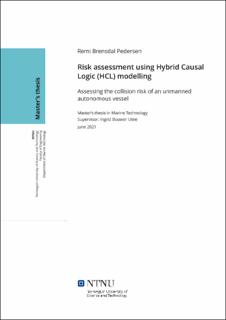| dc.contributor.advisor | Utne, Ingrid Bouwer | |
| dc.contributor.author | Pedersen, Remi Brensdal | |
| dc.date.accessioned | 2021-10-21T18:09:33Z | |
| dc.date.available | 2021-10-21T18:09:33Z | |
| dc.date.issued | 2021 | |
| dc.identifier | no.ntnu:inspera:78668897:21023846 | |
| dc.identifier.uri | https://hdl.handle.net/11250/2824627 | |
| dc.description.abstract | Autonome skip utvikles for tiden for bruk i offentlige farvann. Et av kravene til autonome skip er at de skal være minst like sikre som konvensjonelle skip. For å oppnå dette er effektiv samhandling og kommunikasjon mellom programvare, maskinvare og mennesker avgjørende.
Denne oppgaven tar sikte på å vurdere kollisjonsrisikoen til et ubemannet autonomt fartøy, samt undersøke samspillet mellom de menneskelige operatørene på land og skipet. Analysen er basert på Hybrid Causal Logic-modellen (HCL), som kombinerer hendelsessekvensdiagrammer (ESD) med feiltrær og Bayesian Belief Networks (BBN). Dette gjør det mulig å analysere flere aspekter av systemet som en helhet i stedet for bare en.
ESD beskriver scenariet og modellerer hendelsene som kan skje etter den innledende hendelsen, som ble satt til å være et fartøy på kollisjonskurs. Dette inkluderer front-, forbikjøring- og kryssingskollisjon. En ny metode kalt Concurrent Task Analysis (CoTA) som beskriver de forskjellige oppgavene agenten må utføre for at hendelsene skal lykkes, har blitt brukt til å identifisere mellomoppgavene i feiltrærne. Feiltrærne er videreutviklet basert på IDA-modellen. Denne deler sviktmodusene i feil i enten informasjonsinnsamling, beslutningstaking og handling. Feiltrærne illustrerer feilhendelser for både det autonome systemet og de menneskelige operatørene. For å undersøke menneskelige svikthendelser ble BBN imidlertid brukt. En litteraturgjennomgang om menneskelig pålitelighetsanalyse (HRA) og relevante BBN-modeller ble gjennomført for å konstruere BBN modellen. BBN-ene følger den samme strukturen som feiltrærne i den forstand at en BBN ble laget for hver av I-D-A-fasene.
Emnet for risikoanalysen er en forenklet modell av et ekte kystlasteskip som leverer fiskemat langs kysten av Norge. Ruten er satt til gå fra Brønnøysund til Kristiansund. Kvantifisering av den innledende hendelsen i ESD er basert på fartøyfrekvenser og AIS-data. Grunnleggende hendelser i feiltrærne blir kvantifisert ved hjelp av data fra litteraturen, kritiske feilfrekvenser fra OREDA-håndboken og \\
IMO-hendelsesfrekvenser. Data for inngangsnodene i BBN-ene er basert på en studie som vurderer sammarbeidet mellom menneskelig og autonomi for AUV-er.
Resultatene fra denne oppgaven indikerer at sannsynligheten for kollisjon er høyere enn sammenlignbare studier. De sammenlignede studiene involverer imidlertid andre fartøystyper og en annen operativ kontekst. Når det gjelder samspillet mellom det autonome skipet og de menneskelige operatørene, viste resultatene at det autonome skipet er veldig pålitelig. Når det gjelder de menneskelige operatørene, ga resultatene høy sannsynlighet for svikt. Dette er mest sannsynlig på grunn av høy grad av usikkerhet i verdiene som ble brukt kvantifisering, og viser at det må gjøres mer forskning innefor menneskelig pålitelighetsanalyse. | |
| dc.description.abstract | Autonomous ships (AS) are currently being developed for use in public waters. One of the requirements for AS is that they should be at least as safe as conventional ships. To obtain this, efficient interaction and communication between software, hardware and humans are critical.
This thesis aims to assess the collision risk of an unmanned autonomous vessel as well as investigate the interaction between the human operators onshore and the ship. The analysis is based on a Hybrid Causal Logic model(HCL), combining event sequence diagrams(ESD) with fault trees and Bayesian Belief Networks(BBN). This allows for analyzing several aspects of the system as a whole instead of only one.
The ESD describes the scenario and models the events that can happen after the initiating event, which was set to be a vessel on a collision course. This includes head-on-, overtaking- and crossing collision. A novel method called Concurrent Task Analysis (CoTA) which describes the different tasks the agent has to perform in order for the events to succeed, has been used to identify the intermediate tasks in the fault trees. The fault trees are further developed based on the IDA model. This divides the failure modes into failures in either information collection, decision making, and action-taking. The fault trees illustrate failure events for both the autonomous system and the human operators. However, in order to further investigate the human failure events, BBN was used. A literature review on Human Reliability Analysis(HRA) and relevant BBN models was conducted to construct the BBN. The BBN's follows the same structure as the fault trees in the sense that one BBN was made for each of the I-D-A phases.
The subject of the risk analysis is a simplified model of a real coastal cargo ship delivering fish food along the coast of Norway. The route was set to be from Brønnøysund to Kristiansund. Quantification of the initiating event in the ESD is based on vessel frequencies and AIS data. Basic events in the fault trees are quantified using data from the literature, critical failure rates from the OREDA handbook, and IMO event frequencies. Data for the input nodes in the BBN's are based on a study that assesses the human-autonomy collaboration for AUVs.
The results from this thesis indicate that the collision probability is higher than comparable studies. However, the compared studies involves other vessel types and a different operational context. Regarding the interaction between the autonomous ship and the human operators, the results showed that the autonomous ship is very reliable. When it comes to the human operators, the results obtained showed a high probability of failure. This is most likely due to a high degree of uncertainty in the values used for quantification, and shows that more research has to be done on the are of human reliability analysis. | |
| dc.language | eng | |
| dc.publisher | NTNU | |
| dc.title | Risk assessment using Hybrid Causal Logic (HCL) modelling - Assessing the collision risk of an unmanned autonomous vessel | |
| dc.type | Master thesis | |
